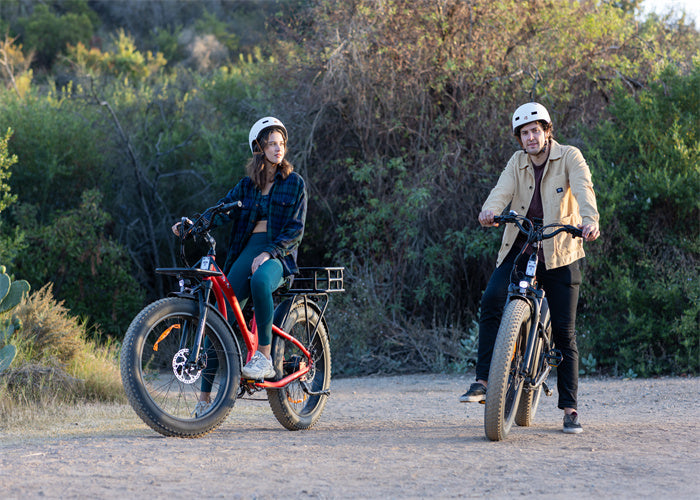All motion eventually halts due to friction. Increasing the frictional force causes something to stop more quickly. Bicycle brakes are designed to slow down a bicycle.
Speed is insignificant without good brakes. Proper bicycle brakes provide control and improve driving dynamics.
Stopping a bike, especially in wet conditions, used to be difficult. Today, modern brakes have eliminated this problem.
How Does a Brake Work?
Brakes are fundamental to controlling the speed and stopping of a bicycle. Essentially, brakes work by converting the kinetic energy of a moving bike into thermal energy through friction, thus slowing down or stopping the bike. This process involves several components, including brake levers, cables or hoses, and brake pads, each playing a pivotal role in the braking mechanism.
When you squeeze the brake lever, it triggers a series of actions that result in the brake pads pressing against a surface to create friction. Depending on the brake type, this surface could be the wheel rim, a rotor, or the hub.

Comen Bike Brake Types
Rim Brakes
Rim brakes are among the oldest and most prevalent bike brake types, commonly found on road bikes and some mountain bikes. They operate by applying friction directly to the wheel rims.
When you squeeze the brake lever, it pulls a cable that causes the brake pads to clamp onto the wheel rims. This action generates friction, which slows down the bike.
Rim brakes are lightweight and cost-effective. They are easy to maintain and replace, and their simple design makes them a favorite for many cyclists. Additionally, their affordability makes them accessible for all types of riders.
Rim brakes tend to wear out the wheel rims over time, necessitating frequent replacements. They also perform poorly in wet or muddy conditions because water and mud can reduce friction between the brake pads and rims, compromising stopping power.
Rim brakes are commonly used on road bikes due to their light weight and efficiency on paved surfaces. They are less common on mountain bikes and e-bikes, where more robust braking systems are preferred.

Disc Brakes
Disc brakes have gained popularity in recent years, especially on mountain bikes and e-bikes, due to their superior stopping power and consistent performance in various conditions.
Disc brakes use a rotor attached to the wheel hub. When you squeeze the brake lever, it actuates a caliper that clamps brake pads onto the rotor, creating friction and slowing down the bike.
Disc brakes provide strong and reliable stopping power in all weather conditions. They are less affected by water and mud, making them ideal for off-road and all-weather riding. Unlike rim brakes, disc brakes do not wear out the wheel rims, which can extend the lifespan of the wheels.
Disc brakes are generally more expensive and require more maintenance compared to rim brakes. They also add weight to the bike, which might be a concern for competitive cyclists focused on minimizing weight.
Disc brakes are widely used on mountain bikes, e-bikes, and high-performance road bikes. Their robustness and reliability make them suitable for various terrains and conditions.

Drum Brakes
Drum brakes are less common but are sometimes found on commuter bikes and some e-bikes. These brakes are enclosed within the wheel hub, protecting them from weather and dirt.
Drum brakes use a drum attached to the wheel hub. When you squeeze the brake lever, it actuates brake shoes that press against the inner surface of the drum, creating friction and slowing down the bike.
Drum brakes are low maintenance because they are enclosed and protected from external elements. They offer consistent braking performance and are particularly suited for urban environments where weather protection is beneficial.
Drum brakes are heavier than other brake types and can be more challenging to repair or replace. They also provide less stopping power compared to disc brakes, which can be a drawback for high-speed or off-road riding.
Drum brakes are typically used on commuter bikes and some e-bikes that prioritize low maintenance and reliability over high performance.

Coaster Brakes
Coaster brakes are commonly found on single-speed bikes and children's bikes. They are unique in that they are operated by pedaling backward.
When the rider pedals backward, it engages the coaster brake mechanism inside the rear hub, causing brake shoes to press against the hub shell and create friction, slowing down the bike.
Coaster brakes are simple to use and do not require hand operation, making them ideal for casual riders and children. They are also low maintenance since they are enclosed within the hub and protected from dirt and weather.
Coaster brakes provide less stopping power and can overheat on long descents. They are not suitable for high-performance riding or e-bikes that require strong and reliable braking.
Coaster brakes are typically found on single-speed bikes, children's bikes, and some cruiser bikes. They are ideal for leisurely rides on flat terrain.

Hydraulic Brakes
Hydraulic brakes are considered the gold standard for high-performance bikes, including e-bikes. They offer the best modulation and stopping power.
Hydraulic brakes use fluid to transmit force from the brake lever to the brake caliper. When you squeeze the brake lever, it pushes fluid through a hose, which in turn actuates the brake caliper to clamp the brake pads onto the rotor, creating friction and slowing down the bike.
Hydraulic brakes provide exceptional modulation and stopping power, making them ideal for high-performance and off-road riding. They are also self-adjusting, which means they require less frequent maintenance.
Hydraulic brakes are more complex and expensive to maintain compared to mechanical brakes. They require specialized knowledge and tools for repairs, which can be a drawback for some riders.
Hydraulic brakes are commonly used on high-end mountain bikes, e-bikes, and performance road bikes. Their superior performance makes them the preferred choice for serious cyclists and off-road enthusiasts.

What Brake is Commonly Used on E-Bikes Nowadays
E-bikes require robust and reliable braking systems due to their increased weight and higher speeds. Among the brake types discussed, disc brakes and hydraulic brakes are the most commonly used on e-bikes.
Disc Brakes are popular for their reliability and performance in various weather conditions. They provide consistent stopping power, which is crucial for e-bikes that often travel at higher speeds. Furthermore, disc brakes are less affected by dirt and moisture, making them suitable for all-terrain riding.
Tesway's ebikes feature premium rim brakes that provide effective braking, helping to prevent accidents. Tesway prioritizes safety, ensuring a smooth and secure ride. Fair price for best quality electric bicycle.
Hydraulic Brakes, on the other hand, offer the best performance for high-end e-bikes. Their superior modulation and stopping power make them ideal for riders who demand the highest level of control and safety. Although they require more maintenance, the benefits they provide often outweigh the additional effort.

Which Bicycle Brake Type Is The Best
Ultimately, the "best" brake for your e-bike depends on your specific needs and riding conditions.
Rim Brakes: Best for casual riders who prioritize cost and ease of maintenance.
Disc Brakes: Ideal for most e-bike riders, offering a good balance of performance, reliability, and ease of maintenance.
Hydraulic Brakes: Perfect for high-performance e-bikes and riders who want the best possible braking performance.
Ultimately, the "best" brake for your e-bike depends on your specific needs and riding conditions.
FAQs
Are disc brakes worth the extra cost for e-bikes?
Yes, disc brakes provide superior performance and safety, especially in adverse weather conditions, making them a worthwhile investment for e-bikes.
Can I upgrade my e-bike from rim brakes to disc brakes?
Yes, but it requires compatible components and may involve significant modifications. It's best to consult with a professional before making such an upgrade.
How often should I service my e-bike brakes?
Regular maintenance is essential. For disc brakes, check the pads and rotors every few months. Hydraulic systems should be bled annually or if you notice a decrease in performance.







Share:
2024 Best Folding E-Bike for Steep Hills
Find Out Which Bike Style Suits You Best: Step-Through or Step-Over